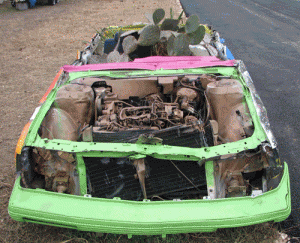Will the US Supreme Court Decide What Is Art?
 The College Art Association (“CAA”), some artists, and a few other organizations have filed a “friend of the court” brief with the US Supreme Court asking the nine justices to hear a case concerning a removed artwork and the city of San Marcos, Texas. (pdf version of brief here.)
The College Art Association (“CAA”), some artists, and a few other organizations have filed a “friend of the court” brief with the US Supreme Court asking the nine justices to hear a case concerning a removed artwork and the city of San Marcos, Texas. (pdf version of brief here.)
CAA argues that the Fifth Circuit Court of Appeals made a grave error by declaring that the advertising art “installation” in front of a business establishment was not “great art.” (Background here.) However, as I read the Fifth Circuit’s decision, they’re not saying that at all. What the Fifth Circuit is saying–rightly–is that when visual objects contain both speech and non-speech factors, intermediate scrutiny will apply and therefore grant the state the right to limit that speech. The Fifth Circuit also argues that when it is a mixture of expressive and non-expressive speech, the tedious task of deciding which it is is a case-by-case problem.
In the case of the City of San Marcos (Kleinman v. City of San Marcos), the Fifth Circuit rightly asserts:
Irrespective of the intentions of its creators or Planet K’s owner, the car-planter is a utilitarian device, an advertisement, and ultimately a “junked vehicle.” These qualities objectively dominate any expressive component of its exterior painting.
Finding that the car-planter was a utilitarian device with incidental expressive content, the Fifth Circuit looked to the Eighth Circuit’s reasoning when it faced a similar quandary. The Eighth Circuit,
… confronted … with a wrecked auto that was displayed streetside to remind the public how the owner’s son had been killed, had no difficulty finding that the auto’s removal under a junked-vehicle ordinance survived intermediate scrutiny. Davis v. Norman, 555 F.2d 189 (8th Cir.1977). When the “expressive” component of an object, considered objectively in light of its function and utility, is at best secondary, the public display of the object is conduct subject to reasonable state regulation. We therefore pretermit “recourse to principles of aesthetics.”
In other words, the question is not whether the “planter” is art or great art. The Supreme Court has already decided that. The question is whether the “planter,” which has both speech and non-speech factors, and its location, can be regulated by government. It appears that it can. I sincerely doubt the US Supreme Court will grant certiorari (to hear the case). Good luck!
Tags: art as expression, artistic expression, censorship, installation art, non-art, public art, sculpture



Comments